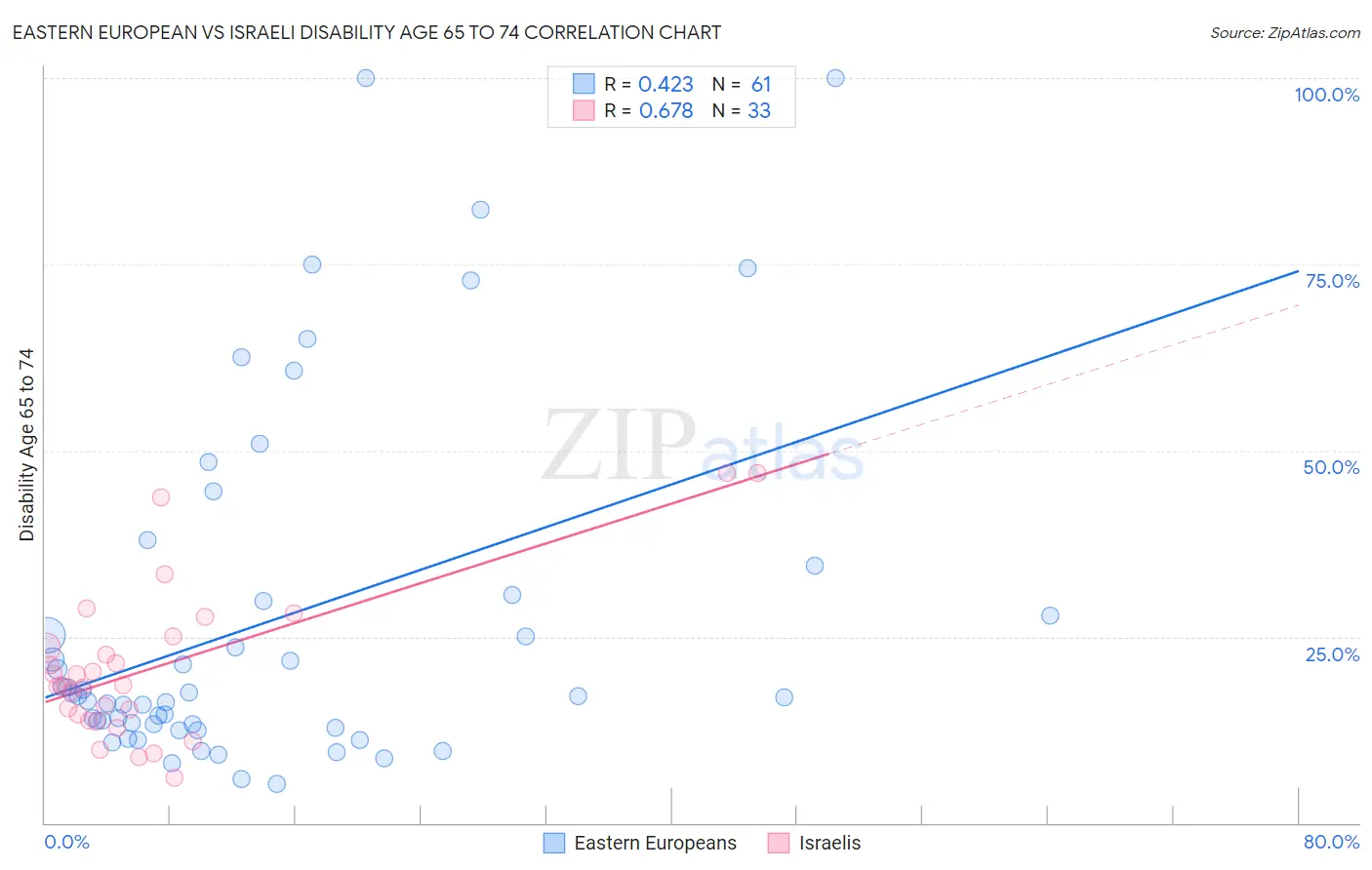Eastern European vs Israeli Disability Age 65 to 74
COMPARE
Eastern European
Israeli
Disability Age 65 to 74
Disability Age 65 to 74 Comparison
Eastern Europeans
Israelis
20.6%
DISABILITY AGE 65 TO 74
100.0/ 100
METRIC RATING
18th/ 347
METRIC RANK
21.2%
DISABILITY AGE 65 TO 74
99.8/ 100
METRIC RATING
37th/ 347
METRIC RANK
Eastern European vs Israeli Disability Age 65 to 74 Correlation Chart
The statistical analysis conducted on geographies consisting of 460,228,956 people shows a moderate positive correlation between the proportion of Eastern Europeans and percentage of population with a disability between the ages 65 and 75 in the United States with a correlation coefficient (R) of 0.423 and weighted average of 20.6%. Similarly, the statistical analysis conducted on geographies consisting of 210,778,329 people shows a significant positive correlation between the proportion of Israelis and percentage of population with a disability between the ages 65 and 75 in the United States with a correlation coefficient (R) of 0.678 and weighted average of 21.2%, a difference of 2.6%.

Disability Age 65 to 74 Correlation Summary
| Measurement | Eastern European | Israeli |
| Minimum | 5.2% | 6.1% |
| Maximum | 100.0% | 46.9% |
| Range | 94.8% | 40.8% |
| Mean | 27.0% | 20.8% |
| Median | 17.0% | 18.5% |
| Interquartile 25% (IQ1) | 13.0% | 14.2% |
| Interquartile 75% (IQ3) | 30.2% | 24.3% |
| Interquartile Range (IQR) | 17.2% | 10.1% |
| Standard Deviation (Sample) | 23.5% | 10.1% |
| Standard Deviation (Population) | 23.4% | 10.0% |
Demographics Similar to Eastern Europeans and Israelis by Disability Age 65 to 74
In terms of disability age 65 to 74, the demographic groups most similar to Eastern Europeans are Burmese (20.6%, a difference of 0.030%), Immigrants from South Central Asia (20.6%, a difference of 0.070%), Okinawan (20.7%, a difference of 0.35%), Immigrants from Bolivia (20.8%, a difference of 1.1%), and Immigrants from Iran (20.9%, a difference of 1.3%). Similarly, the demographic groups most similar to Israelis are Immigrants from Switzerland (21.1%, a difference of 0.11%), Bulgarian (21.1%, a difference of 0.30%), Immigrants from Sri Lanka (21.1%, a difference of 0.36%), Immigrants from Argentina (21.1%, a difference of 0.39%), and Turkish (21.0%, a difference of 0.59%).
| Demographics | Rating | Rank | Disability Age 65 to 74 |
| Immigrants | South Central Asia | 100.0 /100 | #17 | Exceptional 20.6% |
| Eastern Europeans | 100.0 /100 | #18 | Exceptional 20.6% |
| Burmese | 100.0 /100 | #19 | Exceptional 20.6% |
| Okinawans | 100.0 /100 | #20 | Exceptional 20.7% |
| Immigrants | Bolivia | 99.9 /100 | #21 | Exceptional 20.8% |
| Immigrants | Iran | 99.9 /100 | #22 | Exceptional 20.9% |
| Immigrants | Belgium | 99.9 /100 | #23 | Exceptional 21.0% |
| Soviet Union | 99.9 /100 | #24 | Exceptional 21.0% |
| Bolivians | 99.9 /100 | #25 | Exceptional 21.0% |
| Immigrants | Australia | 99.9 /100 | #26 | Exceptional 21.0% |
| Immigrants | Sweden | 99.9 /100 | #27 | Exceptional 21.0% |
| Immigrants | Czechoslovakia | 99.9 /100 | #28 | Exceptional 21.0% |
| Immigrants | Japan | 99.9 /100 | #29 | Exceptional 21.0% |
| Immigrants | Greece | 99.9 /100 | #30 | Exceptional 21.0% |
| Immigrants | Northern Europe | 99.9 /100 | #31 | Exceptional 21.0% |
| Turks | 99.9 /100 | #32 | Exceptional 21.0% |
| Immigrants | Argentina | 99.9 /100 | #33 | Exceptional 21.1% |
| Immigrants | Sri Lanka | 99.9 /100 | #34 | Exceptional 21.1% |
| Bulgarians | 99.9 /100 | #35 | Exceptional 21.1% |
| Immigrants | Switzerland | 99.8 /100 | #36 | Exceptional 21.1% |
| Israelis | 99.8 /100 | #37 | Exceptional 21.2% |